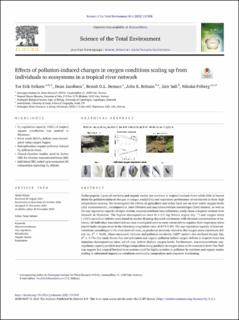| dc.contributor.author | Eriksen, Tor Erik | |
| dc.contributor.author | Jacobsen, Dean | |
| dc.contributor.author | Demars, Benoît O.L. | |
| dc.contributor.author | Brittain, John E | |
| dc.contributor.author | Søli, Geir | |
| dc.contributor.author | Friberg, Nikolai | |
| dc.date.accessioned | 2022-03-11T09:54:27Z | |
| dc.date.available | 2022-03-11T09:54:27Z | |
| dc.date.created | 2021-12-16T12:07:38Z | |
| dc.date.issued | 2021 | |
| dc.identifier.citation | Science of the Total Environment. 2021, 814, 151958. | en_US |
| dc.identifier.issn | 0048-9697 | |
| dc.identifier.uri | https://hdl.handle.net/11250/2984548 | |
| dc.description.abstract | Anthropogenic inputs of nutrients and organic matter are common in tropical lowland rivers while little is known about the pollution-induced changes in oxygen availability and respiratory performance of ectotherms in these high temperature systems. We investigated the effects of agriculture and urban land-use on river water oxygen levels (diel measurements), decomposition rates (Wettex) and macroinvertebrate assemblages (field studies), as well as the oxy-regulatory capacity of eight riverine macroinvertebrate taxa (laboratory study) from a tropical lowland river network in Myanmar. The highest decomposition rates (0.1–5.5 mg Wettex degree day−1) and oxygen stress (≤91% saturation deficits) were found in reaches draining degraded catchments with elevated concentrations of nutrients. All individual macroinvertebrate taxa investigated were to some extent able to regulate their respiration when placed under oxygen stress in the laboratory (regulation value of 0.74–0.89). The oxy-regulation capacity of macroinvertebrate assemblages in the river network were, as predicted, inversely related to diel oxygen stress (maximum deficit; lm, R2 = 0.69), where taxonomic richness and pollution sensitivity (ASPT metric) also declined sharply (lm, R2 ≥ 0.79). Our study shows that eutrophication and organic pollution induce oxygen deficits in tropical rivers but stimulate decomposition rates, which may further deplete oxygen levels. Furthermore, macroinvertebrate oxy-regulatory capacity predicts assemblage composition along gradients in oxygen stress at the ecosystem level. Our findings suggest that tropical lowland river systems could be highly sensitive to pollution by nutrients and organic matter leading to substantial impacts on ectotherm community composition and ecosystem functioning. | en_US |
| dc.language.iso | eng | en_US |
| dc.publisher | Elsevier | en_US |
| dc.rights | Navngivelse 4.0 Internasjonal | * |
| dc.rights.uri | http://creativecommons.org/licenses/by/4.0/deed.no | * |
| dc.title | Effects of pollution-induced changes in oxygen conditions scaling up from individuals to ecosystems in a tropical river network | en_US |
| dc.type | Peer reviewed | en_US |
| dc.type | Journal article | en_US |
| dc.description.version | publishedVersion | en_US |
| dc.rights.holder | © 2021 The Authors | en_US |
| dc.source.pagenumber | 11 | en_US |
| dc.source.journal | Science of the Total Environment | en_US |
| dc.identifier.doi | 10.1016/j.scitotenv.2021.151958 | |
| dc.identifier.cristin | 1969390 | |
| dc.source.articlenumber | 151958 | en_US |
| cristin.ispublished | true | |
| cristin.fulltext | original | |
| cristin.qualitycode | 2 | |

